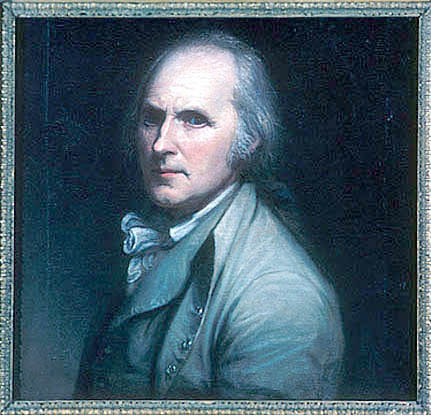About this Portrait:
Near the end of his life, Charles Willson Peale defined his creative philosophy: Mediocrity is scarcely admissable [sic] in the art of painting. It must be perfect in the representation or it is of no value. With this frame of mind, Peale painted several self-portraits during his long career. Most place him in his professional capacity with the tools of his trade. The rest portray him at close range without props, much like the depictions of famous men that he created for his museum gallery. Peale listed two portraits of himself in the 1795 Philadelphia Museum catalog.
Ownership History:
Descended in the family of Charles Linnaeus Peale. Acquired by Mrs. T. Charlton Henry. Inherited by Julia Biddle Henry. Purchased for Independence National Historical Park by the Friends of Independence Park in 1979.
Charles Willson Peale's masterly portraits connect us directly to real people. Peale captures his subject's character and essence. The paintings also provide information on class, background, and social status. Peale's portraits honor individuals who made contributions to the American Revolution.

|
|
|
|
 eale was born on April 15, 1741 in Queen Anne's County, Maryland. After the death of his father, he was apprenticed to an Annapolis saddler. He attributed his first interest in painting to a time when he saw several landscapes and portraits in the home of a client. Peale thought the paintings were poorly done and tried his own hand at producing something better. He took a few lessons with his neighbor, professional artist John Hesselius, and he visited John Singleton Copley in his Boston studio. Impressed by Peale's amateur ability, a prosperous family friend collected subscriptions from other wealthy Annapolis residents and sent the young man to London for further study. Peale spent two years there in the studio of the American expatriate artist Benjamin West. On his return to Annapolis in 1769, Peale opened his own painting room and exhibited his work to prospective clients. He remained there until 1775 when he moved his family to Philadelphia. eale was born on April 15, 1741 in Queen Anne's County, Maryland. After the death of his father, he was apprenticed to an Annapolis saddler. He attributed his first interest in painting to a time when he saw several landscapes and portraits in the home of a client. Peale thought the paintings were poorly done and tried his own hand at producing something better. He took a few lessons with his neighbor, professional artist John Hesselius, and he visited John Singleton Copley in his Boston studio. Impressed by Peale's amateur ability, a prosperous family friend collected subscriptions from other wealthy Annapolis residents and sent the young man to London for further study. Peale spent two years there in the studio of the American expatriate artist Benjamin West. On his return to Annapolis in 1769, Peale opened his own painting room and exhibited his work to prospective clients. He remained there until 1775 when he moved his family to Philadelphia.
 uring the Revolution and the early years of the American republic, Peale painted more than 300 portraits. Many of these hung in his Philadelphia Museum, first opened in his home at Third and Lombard Streets in 1784. Ten years later, the artist expanded his museum to include natural history specimens and moved the collection to the headquarters of the American Philosophical Society. There, Peale was the first to display birds and mammals in museum cases with painted backgrounds that depicted the creatures' natural habitats. Scientific pursuits, like the discovery of mastodon bones in New York State, and the museum's move to the second floor of the Pennsylvania State House (now called Independence Hall) in 1802 so preoccupied Peale that he stopped painting from 1799 until 1804. uring the Revolution and the early years of the American republic, Peale painted more than 300 portraits. Many of these hung in his Philadelphia Museum, first opened in his home at Third and Lombard Streets in 1784. Ten years later, the artist expanded his museum to include natural history specimens and moved the collection to the headquarters of the American Philosophical Society. There, Peale was the first to display birds and mammals in museum cases with painted backgrounds that depicted the creatures' natural habitats. Scientific pursuits, like the discovery of mastodon bones in New York State, and the museum's move to the second floor of the Pennsylvania State House (now called Independence Hall) in 1802 so preoccupied Peale that he stopped painting from 1799 until 1804.
 uring this time, Peale continued his efforts to found an art school in Philadelphia, beginning with the short-lived Columbianum and expanding to the Pennsylvania Academy of the Fine Arts. Most of Peale's nine adult children received early and rigorous instruction in the art of drawing; Raphaelle, Rembrandt, Rubens, Titian Ramsay II, and their cousins Sarah Miriam and Anna Claypoole Peale all became professional artists under the senior Peale's tutelage. Peale returned to his easel, inspired by the experience his son Rembrandt gained during a sojourn in Paris, where the younger man studied at art academies. Charles Willson Peale continued to paint both private commissions and museum portraits until shortly before his death on February 22, 1827. uring this time, Peale continued his efforts to found an art school in Philadelphia, beginning with the short-lived Columbianum and expanding to the Pennsylvania Academy of the Fine Arts. Most of Peale's nine adult children received early and rigorous instruction in the art of drawing; Raphaelle, Rembrandt, Rubens, Titian Ramsay II, and their cousins Sarah Miriam and Anna Claypoole Peale all became professional artists under the senior Peale's tutelage. Peale returned to his easel, inspired by the experience his son Rembrandt gained during a sojourn in Paris, where the younger man studied at art academies. Charles Willson Peale continued to paint both private commissions and museum portraits until shortly before his death on February 22, 1827.
|
|
|

